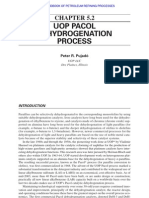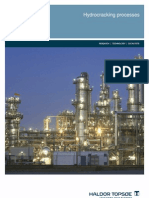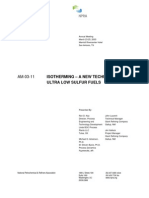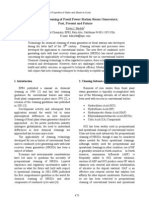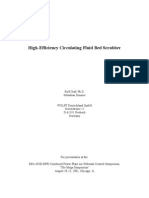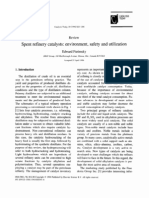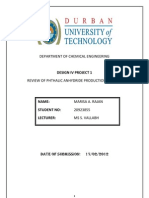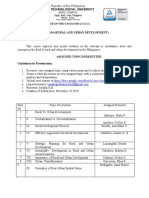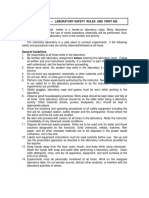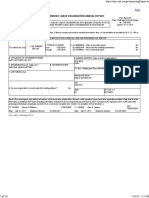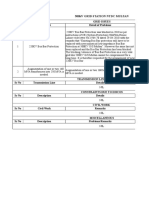Alkysafe
Alkysafe
Uploaded by
Nabeel ShaukatCopyright:
Available Formats
Alkysafe
Alkysafe
Uploaded by
Nabeel ShaukatCopyright
Available Formats
Share this document
Did you find this document useful?
Is this content inappropriate?
Copyright:
Available Formats
Alkysafe
Alkysafe
Uploaded by
Nabeel ShaukatCopyright:
Available Formats
DuPont STRATCO ALKYSAFE STRATCO has determined that both Phillips, and UOP designed HF alkylation units can
be converted and expanded into H2SO4 alkylation units with minimum capital expense. Although the converted units will not employ STRATCO Contactor reactors, the alkylate octane will be higher than that of the original HF units in many cases. The alkylate product rate can usually be substantially increased, since the H2SO4 process optimally operates at a lower external isobutane to olefin (I/O) ratio than the HF process. Therefore, the same fractionation equipment will typically support increased alkylate production. The cost of the expansion is estimated to be comparable to the average cost of installing effective HF aerosol mitigation and isolation equipment. Much of the reaction zone equipment may be modified and reused. The fractionators typically require no major modifications. The only new major equipment required are a closed-loop refrigeration system, a treating section for the reactor effluent, acid blowdown and storage facilities. Some existing equipment may be reused in the acid blowdown section of the unit. Several refiners have expressed interest in this process because of the safety and expansion benefits.
BACKGROUND Many refiners have increasing needs for additional alkylation capacity, to meet reformulated gasoline regulations, lower gasoline vapor pressure requirements, and/or increased gasoline demand. However, the owners and operators of HF alkylation units in most parts of the world are faced with public concern and regulatory attention regarding the safety of their units. The problem, of course, is that the catalyst forms a hazardous aerosol when released as a superheated liquid. This dense aerosol cloud has the potential to persist at toxic concentrations for long distances downwind of a release. While the industry's record has been good, this potential has led environmental activist groups and various regulatory bodies to attack the use of HF in refining and chemical plants. For these reasons, it is often very difficult to obtain permits to expand an existing HF unit, or build a new
alkylation unit. This trend is clearly seen by the fact that an overwhelming majority of the alkylation units constructed worldwide during the 1990s use H2SO4 catalyst.
OPTIONS FOR HF ALKYLATION UNITS What options do refiners have in responding to regulatory pressure intended to assure the safety of their HF alkylation units? Fundamentally, there are three approaches that may be taken: mitigation, HF modifiers, or conversion to another catalyst, such as sulfuric acid. We will explore each of these options in more detail. MITIGATION Currently, mitigation of the downwind impact of an HF release is the option most frequently employed. Mitigation systems usually include detection, isolation, water spray, and remote de-inventory facilities. The first goal of these systems is to detect an incipient acid release. Once a leak is detected, the goal becomes to reliably isolate the major inventories of acid from the release; remove the acid from the leaking portion of the unit to a safe storage location; and finally, erect a wall of water between the leak and the community, to absorb a substantial amount of the acid cloud on site. Based on responses at Oil and Gas Journal's seminar on alkylation in Houston (October 31-November 1, 1994), the typical cost of adding mitigation facilities to an existing HF alkylation unit is between $20 and $30 million (U.S.). One Los Angeles refiner reportedly spent $50 million (U.S.) on its mitigation system. To be effective, mitigation facilities must be fast-acting. The water curtain and water cannons must be in operation within seconds after the onset of the release. Isolation and HF deinventory operations must take place within minutes. All of these facilities must be tested at some regular frequency, to ensure they are operable. Deinventory systems usually involve large vessels with large acid movement devices. Plant isolation systems may require from 10 to 80 remote-operated, fireproofed, testable valves, and may also require additional pressure relief valves in HF service.
The reliability of mitigation systems is unknown at this time. Also, this large capital expenditure provides no process benefit to the alkylation unit (i.e., no increase in capacity or product quality). HF MODIFIERS Modification of the physical properties of the HF catalyst is a second avenue the refiner may explore. Much research is focused on the development of HF modifiers (chemical additives) that reduce the volatility and aerosol formation properties of HF. Recent tests of two of these additives have indicated substantial reductions in HF aerosol and vapor cloud formation. Figures quoted are in the range of 63-80% reduction of airborne HF due to the additive. Additives to modify the properties of HF are still in the developmental stage. Their effectiveness in reducing HF aerosol formation is commercially unproven at present. The capital and operating cost of a commercial installation is not known, but could be significant. The developers of the HF modifiers foresee using the additive in conjunction with an effective mitigation system. When coupled with a water application system designed for a 40/1 water/HF ratio, reduction in the quantity of airborne HF would be in the range of 95-97%, compared to an unmitigated release from an alkylation unit without additive. This combination may be required to meet the ultimate rules set by the regulators. CONVERSION The third option is to convert the alkylation unit to use a catalyst that has no aerosol-forming tendencies. Sulfuric acid is the most likely catalyst to replace HF because it is commercially proven and does not form an aerosol. Other potential catalysts such as solid catalysts (SbF5, BF3, AlCl3, Zr(SO4)2, or Trifluoromethane Sulfonic Acid on solid carriers), are not being considered in this paper, since they have not proven to be economically or commercially viable to date. HF properties are much different from the properties of sulfuric acid catalyst, and therefore, the optimum reaction conditions are different. The major process differences in a sulfuric acid alkylation unit are lower reaction temperatures and pressures, higher mixing energies, and effluent treatment of the reactor effluent prior to fractionation. One of the major benefits of the
conversion is a lower optimum isobutane to olefin (I/O) ratio in the H2SO4 process. Less fractionation capacity is required, meaning that the feed and product rates can typically be increased without sacrificing alkylate quality. STRATCO presented a paper at the 1988 NPRA Annual Meeting entitled, Conversion from HF to H2SO4 Alkylation: Incentives, Benefits, and Capital Considerations" (AM-88-67). The conversion method discussed in that paper requires replacement of most of the equipment in the unit, except for the distillation towers. This includes replacement of the HF reaction zone with STRATCO Contactor reactors and an effluent refrigeration system. This previous form of conversion has octane, acid consumption, and capacity advantages over the one discussed in this paper. However, the downside of the previous form of conversion is that replacing the reaction zone and installing the more complicated refrigeration configuration is typically more capital-intensive, and requires more plot space and a longer downtime. THE STRATCO ALKYSAFE PROCESS The ALKYSAFE process reuses both the reaction and distillation sections. It may also be possible to construct much of the acid blowdown section from existing equipment. The majority of the new equipment (packaged refrigeration unit, effluent treating system, acid blowdown and tankage sections) can be constructed in advance of the conversion. With planning, the remaining modifications and tie-ins can be completed within a four-week FCC turnaround. The short downtime and low capital equipment requirements make this process cost-competitive with the mitigation systems currently being installed on HF alkylation units. The process flow of the converted unit will somewhat resemble the time tank units built between 1938 and 1958. This proven technology has been modernized to incorporate STRATCO alkylation knowledge gained over the past 55 years. The converted reaction zone will consist of acid settlers with external emulsion pumps and reaction chillers. As compared to modern STRATCO effluent refrigerated alkylation units with state-of-the-art Contactors reactors, the octanes may be up to one octane number lower and the acid consumption will be approximately 10% higher. However, in many cases, the converted unit's alkylate octanes will be higher than the original HF unit especially if the feeds contain a high concentration of MTBE
raffinate or amylenes, since they are more suitable for H2SO4 alkylation. The following is a description of the process differences and the resulting modifications which must be made in order to convert an HF unit to an H2SO4 alkylation unit via the ALKYSAFE process. Although there are nomenclature and process differences between the two HF licensors, this discussion generically describes the equipment modifications to apply to both Phillips and UOP HF units. REACTION ZONE The sulfuric acid alkylation reaction is optimized by emulsifying the H2SO4 and hydrocarbon reaction mixture to maximize the surface area of the isobutane within the continuous acid phase. This reduces the side reactions and increases the desired alkylation reaction. Only a small amount of mixing is required in the reaction zone of an HF unit, because isobutane is much more soluble in HF than in H2SO4. Therefore, the conversion requires equipment to provide sufficient emulsification in the reaction zone. Emulsion pumps and static mixers are added between the acid settlers and the reaction coolers. This provides the necessary pressure drop and turbulence to emulsify the H2SO4 and hydrocarbon mixture. The hydrocarbon feeds are injected into the suction of the emulsion pumps, rather than directly into the reaction chillers as with the original HF unit. The emulsion will flow from the pumps through the reaction chillers, and then to the acid settler. Additional surface area may be required in the reaction chiller section, depending on the desired design alkylate rate. The trays and other internals of the acid settlers are removed or modified, to minimize turbulence. Since the H2SO4 and hydrocarbon are highly emulsified, the hydrocarbon takes much longer to separate from the H2SO4 than from the HF. Depending on the residence time in the system, additional settling volume may be needed to provide adequate hold-up time, to facilitate separation of the hydrocarbon and spent acid. However, some carryover of acid in the hydrocarbon effluent is not a problem, since it will be recovered in the downstream acid wash. Most types of monel material in potential contact with H2SO4 (>50 wt%) should be replaced with carbon steel or Alloy 20. Valves in frequent contact with H2SO4 should be constructed with Alloy 20 trim.
REFRIGERATION SECTION Both the HF and the H2SO4 alkylation reactions release significant (but similar) amounts of heat. The HF reaction occurs at approximately 100F (38C) and uses cooling water to remove the heat of reaction. The H2SO4 reaction is optimized at 45-50F (7-10C), which requires a refrigeration section to remove the heat of reaction. Therefore, the water-cooled reaction coolers are to be replaced or modified to refrigerated reaction chillers. A closed-loop, packaged propane (or Freon substitute) refrigeration section is added to the unit. Since the heat loads are similar, the net cooling tower load for the plant remains about the same after conversion. In order to minimize cooling requirements, the entire reaction zone is insulated with cold insulation. Also, feed/effluent exchangers are added to the unit to further conserve refrigeration energy. If the reaction zone feeds are not dry (see effluent treating section), pre-cooling the feed has the added benefit of dropping out free water, which can be removed in a coalescer to reduce acid dilution (consumption). Figures 1 and 2 show the reaction zone modifications required in both a Phillips and a UOP HF unit: Figure 1: Phillips Reaction Zone Modifications o New Modify Retire o Acid Settler o Reaction Chillers o HF Acid Storage (After Settler) o HF Acid Recontactor o Emulsion Pumps o Feed/Effluent Exchangers o STRATCO Acid Analyzer
Figure 2: UOP Reaction Zone Modifications o New Modify
o Acid Settler o Reaction Chillers o After Settler o Emulsion Pumps o Feed/Effluent Exchangers o STRATCO Acid Analyzer
REACTOR EFFLUENT TREATING The effluent from the H2SO4 alkylation reaction contains small quantities of organic sulfates (esters), which, if not removed, can contribute to fouling and corrosion in the fractionation section. A treating system is therefore added to remove these components from the reactor effluent. This can either be STRATCO standard fresh acid wash (with electrostatic precipitator) followed by a hot alkaline water wash or an alternate fresh acid wash (with EP) followed by a bauxite treater. Retired vessels in the existing unit may be modified for use in the effluent-treating system. The bauxite treater option has the added benefit of keeping the recycled isobutane dry. If the feed dryers that already exist in the HF unit are reused in combination with bauxite treating, almost no water will enter the reaction zone. This will lower acid consumption, increase the alkylate octane and minimize corrosion rates in the unit. Figure 3 shows STRATCO standard fresh acid wash / hot alkaline water wash system: Figure 3: STRATCO Standard Fresh Acid / Alkaline Water Wash FRACTIONATION The fractionation systems in the various HF unit designs vary significantly from one unit to another even from the same licensor. However, each design has the common purpose of separating propane, recycle isobutane, normal butane and alkylate from the reactor effluent stream (and possibly a lowpurity makeup isobutane feed). The fractionators will have the same function after the conversion, but will have more capacity (for a given olefin feed rate) for the following reasons:
The HF-catalyzed reaction generates propane via a hydrogen-transfer side reaction: C3= + iC4 --> C3 + iC4= This reaction is much less significant in H2SO4-catalyzed reactions and therefore the amount of propane produced in the converted unit is negligible. Also, the effluent from the HF reaction zone contains free HF that behaves like ethane in the fractionation section. In order to condense the HF, the depropanizer section operates at a much higher pressure than would be required if no HF were present. Therefore, besides decreasing the propane make, converting the unit also unloads the depropanizer section by lowering the operating pressure and temperatures to a more optimum level (that is, differences in relative volatilities between propane and isobutane will increase). This reduces the reflux rate and the reboiler temperature and duty requirements for a given feed basis. Since the isobutane recycle requirements are less with H2SO4 than with the HF-catalyzed reactions, the deisobutanizer (or isostripper) recycle isobutane flowrate can typically be reduced for a given feed basis. This provides tower capacity for increased alkylate throughput, or for improved alkylate octane. The debutanizer section of the HF unit is typically reboiled with a fired heater to reach a temperature level that thermally decomposes the organic fluorides in the alkylate. Since no fluorides will be present in the converted unit, a steam reboiler can be used in place of the fired heater. Safety, economics, and stack emission issues will determine whether or not the fired heater should be replaced. ACID BLOWDOWN/TANKAGE A blowdown drum is added in order to decant and/or vaporize any remaining hydrocarbon from the spent acid before flowing to tankage. This drum is also used during shutdown, to deinventory the acid from the unit. The existing acid relief neutralizer will stay in service, but plugging with fluoride salts will be eliminated. If the alkaline water wash system is incorporated, a water degassing drum and a water neutralizatiion basin are required for treatment of spent alkaline water before being discharged to the refinery wastewater treatment facility (existing equipment may be repiped and used for this purpose.
New fresh and spent acid tanks are required for the modified unit. The tanks are designed to store acid for 7-10 days of operation. A loading/unloading facility is also needed for moving the acid into trucks or rail cars for transport to and from the regeneration plant. If on-site acid regeneration is desired, modular plants are available at a modest cost, and the loading/unloading facility is not needed. RETIRED EQUIPMENT The HF unit's facilities for acid regeneration, KOH regeneration, disposal of acid-soluble oils (ASO), disposal of calcium fluoride, sodium fluoride and spent caustic are eliminated. And, since the products from H2SO4 alkylation units require no further treatment, the product treaters are no longer necessary. CONCLUSIONS A refiner currently has three options to reduce the safety risk of his HF alkylation unit: mitigation, HF modifiers, or conversion to sulfuric acid catalyst. Of these three options, only conversion is absolutely certain to eliminate the risk of releasing an HF aerosol cloud. A refiner can convert an HF unit to one that uses H2SO4 for approximately the same cost as an effective mitigation system. The refiner will also typically gain additional capacity and higher octane with the conversion. For these reasons, the ALKYSAFE low-cost conversion/expansion process should be considered by all refiners who have plans to increase the capacity or upgrade the safety facilities of their HF alkylation unit. For additional information on this technology, please visit the Contact Us section on the DuPont Clean Technologies website, or call 913-338-2559.
You might also like
- Uop Pacol Dehydrogenation Process: Peter R. PujadóDocument10 pagesUop Pacol Dehydrogenation Process: Peter R. PujadóBharavi K S100% (2)
- Alkylation UnitDocument6 pagesAlkylation UnitFabricio Trosarello100% (1)
- Petroleum Refinery HSE ManualDocument11 pagesPetroleum Refinery HSE ManualFarrukh TouheedNo ratings yet
- Topsoe Hydrocracking Processes 2011Document17 pagesTopsoe Hydrocracking Processes 2011Cal100% (1)
- AlkyDocument37 pagesAlkyMỹ PhanNo ratings yet
- Isotherming - A New Technology For Ultra Low Sulfur FuelsDocument20 pagesIsotherming - A New Technology For Ultra Low Sulfur FuelsGarry DavidNo ratings yet
- HydrotreatingPoster PDFDocument1 pageHydrotreatingPoster PDFekosmind100% (2)
- Alternatives To The Use of MHF at RefineriesDocument5 pagesAlternatives To The Use of MHF at RefineriesSally HayatiNo ratings yet
- Water-Chemistry, Outage-Maintenance Best Practices Highlight Steam Plant WorkshopDocument8 pagesWater-Chemistry, Outage-Maintenance Best Practices Highlight Steam Plant Workshopnktiah1207No ratings yet
- Chemical Cleaning of Fossil Power Station Steam GeneratorsDocument9 pagesChemical Cleaning of Fossil Power Station Steam Generatorssenthil031277100% (1)
- Dear Mr. Krause,: Uop LLCDocument4 pagesDear Mr. Krause,: Uop LLCNguyễn Hồng SơnNo ratings yet
- AlkyDocument34 pagesAlkyjakeson19No ratings yet
- Additives: E-Books Download Weblog: Water Engineering WeblogDocument8 pagesAdditives: E-Books Download Weblog: Water Engineering WeblogalbertofgvNo ratings yet
- Refinery Waste Water Treatment and ReuseDocument8 pagesRefinery Waste Water Treatment and ReuseMahmood VahidNo ratings yet
- Tolaz Yasin. Reactor ReportDocument11 pagesTolaz Yasin. Reactor ReportAram Nasih MuhammadNo ratings yet
- Chloride RemovalDocument12 pagesChloride Removaldilshad kapoor100% (1)
- CFB Graff-Wulff A9RC36Document18 pagesCFB Graff-Wulff A9RC36KECS_kckNo ratings yet
- Re90223 HF Fluids Axial PistonDocument8 pagesRe90223 HF Fluids Axial PistonlamehesNo ratings yet
- Biological Sulfur Recovery UnitDocument19 pagesBiological Sulfur Recovery UnitAchmad Hairil100% (1)
- Chapter 1 ClausDocument13 pagesChapter 1 ClausWoMeiYouNo ratings yet
- Bulletin 918: Selecting Purifiers For Gas ChromatographyDocument8 pagesBulletin 918: Selecting Purifiers For Gas ChromatographyWorking ScientistNo ratings yet
- Uop Molex Process For Production of Normal Paraffins: Stephen W. SohnDocument6 pagesUop Molex Process For Production of Normal Paraffins: Stephen W. SohnMinh ĐàoNo ratings yet
- TopsoeDocument5 pagesTopsoelaiping_lumNo ratings yet
- 011 Npra Qa FCC QuestionsDocument9 pages011 Npra Qa FCC Questionssaleh4060No ratings yet
- Hydrocarbon Blanket Gas System: Guide ForDocument13 pagesHydrocarbon Blanket Gas System: Guide ForhamedNo ratings yet
- HF Alkylation SolutionDocument16 pagesHF Alkylation SolutionEman El DsoukyNo ratings yet
- Uop Catalytic Dewaxing Process: Hemant GalaDocument6 pagesUop Catalytic Dewaxing Process: Hemant GalaBharavi K SNo ratings yet
- Improve FCCU Operations Using ChemicalDocument7 pagesImprove FCCU Operations Using Chemical3668770No ratings yet
- Retrofitting With Non-Cfc Substitutes: September 1994Document51 pagesRetrofitting With Non-Cfc Substitutes: September 1994SK SARFARAZ UDDINNo ratings yet
- nawtec05-11Document20 pagesnawtec05-11PichetNo ratings yet
- DHDS ProcessDocument9 pagesDHDS ProcessSandeep ChallaNo ratings yet
- Penex Process PDFDocument49 pagesPenex Process PDFAhmed Mohamed KhalilNo ratings yet
- T - Spent Refinery CatalystsDocument64 pagesT - Spent Refinery Catalyststhe0meNo ratings yet
- Design Assumptions and CalculationsDocument31 pagesDesign Assumptions and Calculationsshiel175No ratings yet
- CO2 RemovalDocument8 pagesCO2 RemovalVinh PhamthanhNo ratings yet
- Process Intensification Opportunities in Sulfur Recovery UnitsDocument8 pagesProcess Intensification Opportunities in Sulfur Recovery UnitsMorteza alizadehNo ratings yet
- A New Separator Helps FCC Adapt To A New Refinery-Petrochemical Role-EnglishDocument10 pagesA New Separator Helps FCC Adapt To A New Refinery-Petrochemical Role-EnglishMai Ngoc ChienNo ratings yet
- 2009-03 CleanDieselHydroPTQ MustangDocument7 pages2009-03 CleanDieselHydroPTQ Mustanganhchangleloi100% (2)
- Uop FCCDocument23 pagesUop FCCHarish Kotharu100% (1)
- UOP Proper Design NHT Combined Feed Exchanger Equipment PaperDocument9 pagesUOP Proper Design NHT Combined Feed Exchanger Equipment Paperpiolinwalls100% (1)
- Calflo Heat Transfer FluidDocument4 pagesCalflo Heat Transfer FluidderekfisherNo ratings yet
- Methodology For HPP1 Process Technology (Report1)Document4 pagesMethodology For HPP1 Process Technology (Report1)deepak gargNo ratings yet
- 31 - 2 - New York - 04-86 - 0288Document5 pages31 - 2 - New York - 04-86 - 0288Trinh Quang ThanhNo ratings yet
- Sulfur Magazine Ideas For Better Clean Up Jan 09Document0 pagesSulfur Magazine Ideas For Better Clean Up Jan 09Bharat VaajNo ratings yet
- Final Design 1-BtechDocument15 pagesFinal Design 1-BtechMervin NaidooNo ratings yet
- Uop Fluid Catalytic Cracking Process: Charles L. Hemler and Lester F. SmithDocument24 pagesUop Fluid Catalytic Cracking Process: Charles L. Hemler and Lester F. SmithBharavi K SNo ratings yet
- B U L L E T I N: Application EngineeringDocument4 pagesB U L L E T I N: Application EngineeringMaria DazaNo ratings yet
- Solvent Vapor Recovery and VOC Emission ControlDocument8 pagesSolvent Vapor Recovery and VOC Emission ControlAnonymous ocCa18RNo ratings yet
- Uop RCD Unionfining Process: Daniel B. GillisDocument10 pagesUop RCD Unionfining Process: Daniel B. GillisBharavi K S100% (1)
- 3M FAQ FluorinertDocument27 pages3M FAQ Fluorinertpaingod1No ratings yet
- Production of HF From H2SiF6Document9 pagesProduction of HF From H2SiF6Muslem Shah muhammadiNo ratings yet
- Uop Benfield DatasheetDocument2 pagesUop Benfield DatasheetSusan Monteza GrandezNo ratings yet
- LEED Reference Guide For Green Building Design and ConstructionDocument1 pageLEED Reference Guide For Green Building Design and ConstructionHermanManruNo ratings yet
- Bp-Uop Cyclar Process: Lubo ZhouDocument10 pagesBp-Uop Cyclar Process: Lubo ZhouBharavi K SNo ratings yet
- Ammonia SYN Catalyst JM Q and ADocument4 pagesAmmonia SYN Catalyst JM Q and AMaged HegabNo ratings yet
- Global hydrogen trade to meet the 1.5°C climate goal: Part II – Technology review of hydrogen carriersFrom EverandGlobal hydrogen trade to meet the 1.5°C climate goal: Part II – Technology review of hydrogen carriersNo ratings yet
- Itinerary of Travel: Philippine Statistics Authority - TarlacDocument1 pageItinerary of Travel: Philippine Statistics Authority - TarlacC'toik Y DweyNo ratings yet
- KBR-Economic Bottom of The Barrel Processing To Minimize Fuel Oil Production PDFDocument5 pagesKBR-Economic Bottom of The Barrel Processing To Minimize Fuel Oil Production PDFsantiagoNo ratings yet
- AE Best Practises For VMS Design Specification SheetDocument9 pagesAE Best Practises For VMS Design Specification SheetHussainShabbirNo ratings yet
- ZP Teachers Information 28 01 15Document209 pagesZP Teachers Information 28 01 15lalit18970No ratings yet
- Canlubang Security Agency Corporation V NLRCDocument1 pageCanlubang Security Agency Corporation V NLRCMacNo ratings yet
- HallasDocument2 pagesHallasaltieric92No ratings yet
- C DOT Grad Diploma ITI Apprenticeship Recruitment 2023Document2 pagesC DOT Grad Diploma ITI Apprenticeship Recruitment 2023Humpty VlogsNo ratings yet
- BTC - Autopilot - Method - MAKE - 700$-800$ - PER - WEEKDocument4 pagesBTC - Autopilot - Method - MAKE - 700$-800$ - PER - WEEKAnubis JoseNo ratings yet
- Bakker Et Al - 2022 - Noticing As Reasoning in Lesson Study Teams in Initial Teacher EducationDocument14 pagesBakker Et Al - 2022 - Noticing As Reasoning in Lesson Study Teams in Initial Teacher Educationlingkar pena indonesiaNo ratings yet
- Carmona - Contract To Lease - 1st Draft 1 1Document4 pagesCarmona - Contract To Lease - 1st Draft 1 1Jessie GarciaNo ratings yet
- Corporate ManslaughterDocument3 pagesCorporate ManslaughterCarey Nabang'iNo ratings yet
- 320 Parts ManualDocument81 pages320 Parts Manualadcox311No ratings yet
- Cover MDR, MDR Index Dan Pembatas (Rev)Document19 pagesCover MDR, MDR Index Dan Pembatas (Rev)Richard Adolf100% (2)
- Sps. Vicente Dionisio and Anita DionisioDocument1 pageSps. Vicente Dionisio and Anita DionisioDiane Dee YaneeNo ratings yet
- RCPA Schedule of Fees 2024Document3 pagesRCPA Schedule of Fees 2024Omer AltafNo ratings yet
- Cisco Switch Config v2 0Document24 pagesCisco Switch Config v2 0chituoi100% (1)
- Cebu Technological University: Barili Campus Cagay, Barili, Cebu, Philippines Office of The Graduate SchoolDocument2 pagesCebu Technological University: Barili Campus Cagay, Barili, Cebu, Philippines Office of The Graduate SchoolMarlyn CaballeroNo ratings yet
- Laboratory Safety RulesDocument4 pagesLaboratory Safety RulesnyxNo ratings yet
- Operations Manual: IM30AE Non-Directional Overcurrent RelayDocument16 pagesOperations Manual: IM30AE Non-Directional Overcurrent RelaycrcruzpNo ratings yet
- Republic Act No. 9009: Repealing ClauseDocument1 pageRepublic Act No. 9009: Repealing ClauseJudy Ann ShengNo ratings yet
- Child LabourDocument14 pagesChild LabourShiva NandNo ratings yet
- UAW 2016 LM2 CDocument295 pagesUAW 2016 LM2 Cthe kingfishNo ratings yet
- Event Log: DOCSIS (CM) EventsDocument2 pagesEvent Log: DOCSIS (CM) EventsagustinpowerNo ratings yet
- PEOPLE V. HERNANDEZ 99 Phil. 515 (Digest)Document4 pagesPEOPLE V. HERNANDEZ 99 Phil. 515 (Digest)PNP MayoyaoNo ratings yet
- How To Choose Mercedes-Benz Auto Key ProgrammerDocument6 pagesHow To Choose Mercedes-Benz Auto Key Programmerobd365100% (2)
- Windows Explorer Exercise - 201503171549013407Document2 pagesWindows Explorer Exercise - 201503171549013407Antony mutahiNo ratings yet
- Managing Your Career-Linda HillDocument7 pagesManaging Your Career-Linda HillArbindchaudhary67% (3)
- EntrepreneurshipDocument4 pagesEntrepreneurshippaulinejardin355No ratings yet
- Grid Issues SR No Equipment Detail of Problems: 500Kv Grid Station NTDC MultanDocument34 pagesGrid Issues SR No Equipment Detail of Problems: 500Kv Grid Station NTDC MultanAli RazaNo ratings yet
- Reading 38 Financial Reporting QualityDocument5 pagesReading 38 Financial Reporting QualityHaider ShahbazNo ratings yet
